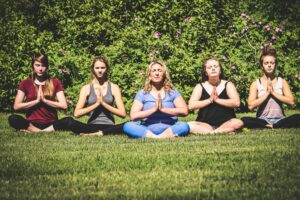
Thank you for stopping by to read the situational factors specific to my educational context.
One of the areas I teach is our yoga curriculum.
Specific Context of the Teaching/Learning Situation
Currently, we have 28 students registered ranging from grade 10 to those in their 5th year of high school looking to take credits to graduate or simply interested in the course material. The delivery is blended between online learning opportunities and in-person workshop days. There are a total of three workshop days and they run from 9:00 – 3:30 with lunch provided. The remainder of the course is offered online. Students choose between a 75 hour 3 credit option and a 125 hour 5 credit option. The theory is asynchronous in delivery. Students can join us for live yoga practices, log their hours from online studio courses, or take classes posted on youtube.
General Context of the Learning Situation
It is expected that the course will help students to see that there are wellness benefits to regular yoga practice and the course will encourage a positive relationship with our bodies and will create a supportive community within the school.
Nature of the Subject
Both theoretical and practical. Practical, the study of physiology and anatomy. Theoretical, the study of yoga philosophy.
Controversy? You bet. Especially in a high school environment.
It is expected that we are very careful about not making anyone uncomfortable or offending anyone by talking about spirituality. We talk about yoga having psychological and physical “benefits” and avoid terminology such as “healing”. I do talk a lot about our relationship to the environment and how nature can help us find balance and help us experience a greater sense of peace and connection within ourselves and others around us… but would never say “it’s good for your spirit.”
Bill 8, the Education Amendment Act, passed last year in Alberta, made it pretty clear that controversial issues (like spirituality and religion) should not be considered teachable moments in our classrooms!
It is a challenge. The curricular outcomes clearly identify learning about the historical roots of yoga. This is embedded in the yoga sutras which help us acknowledge the spiritual aspects of our nature. It’s inevitable that students ask questions and explore their own feelings and understandings.
It is unfortunate as talking about spirituality in the context of yoga leads directly to talking about the Westernization of Eastern traditions which would naturally lead to some powerful discussions surrounding cultural appropriation and comparisons with cultural appreciation. This is incredibly relevant and timely today.
Who am I kidding? I go there. I can’t help myself.
Characteristics of the Learners
Students have all chosen to take yoga as an option so there is generally an interest in the subject area and a desire to participate fully in the course. Many students who attend our alternative programming are struggling with their mental health. Anxiety over meeting classmates and participating in the group workshops often needs to be overcome. We communicate that our practice is everyBODY yoga. Often students would be very hesitant to attend an in-person class at a studio but find our workshops to be very inclusive. Pre-COVID, we even did optional 24-hour unplugged retreats – very fun!
Characteristics of the Teacher
There are two teachers who teach this course, we are both certified teachers as well as certified yoga instructors. We offer yoga because we believe it is a healthy practice for students and provides us with an opportunity to deepen our connection to our students and will ultimately help us guide them along their path to graduation. Highly passionate and motivated teachers!
How might the information gathered through this step help you to design your online learning experience?
This really helps identify that the course delivery is actually pretty messy! We have online synchronous, asynchronous and in-person requirements. This highlights the need to have a comprehensive plan for delivery that can be shared so it will be very clear to students what they need to do to successfully complete the course requirements.
The move online is new this year (due to covid cohort requirements) but something we’d like to be able to continue it.
Confession: we haphazardly decided to do this in the second semester instead of cancelling. A different kind of backwards planning?
How do you think the situational factors might influence design for the online environment versus the face-to-face classroom?
For online components, they need to be asynchronous. Our students have various challenges and schedules that need to be accommodated, we cannot expect them to be available at the same time. Those who work usually can schedule around the full days but are not able to commit to a daily time with us. For the teachers, we are doing small group instruction so online components need to be asynchronous as we are also, simply not available the full course hours for each group of students.
Thank you for sticking with me to the end! I look forward to reading your post this week.
Namaste.
Dee Fink, L. (2003). A self-directed guide to designing courses for significant learning . Retrieved from “http://www.deefinkandassociates.com/GuidetoCourseDesignAug05.pdf”

Leave a Reply
You must be logged in to post a comment.